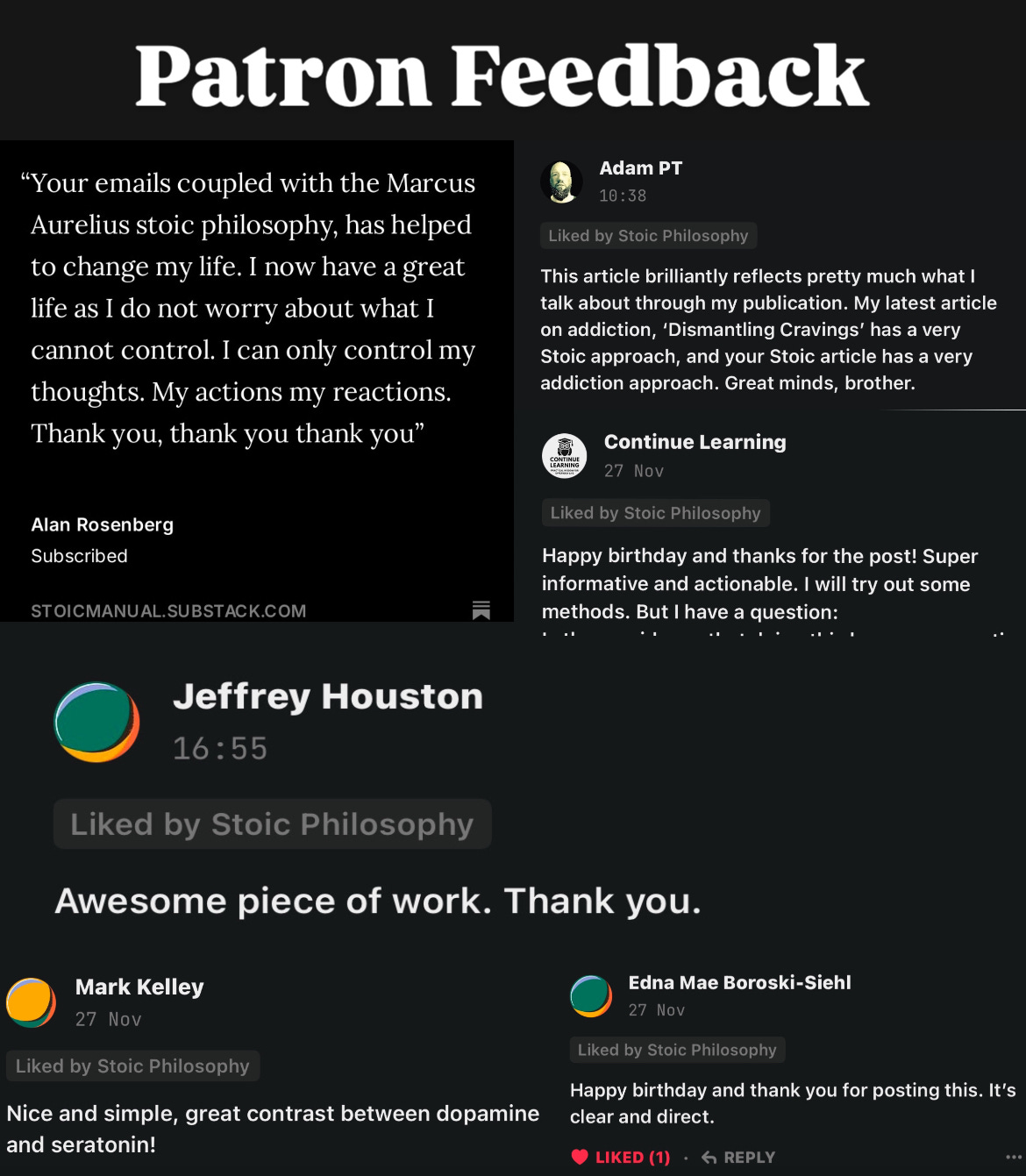#10. How to Cultivate a Gratitude Practice
It’s a transformative practice grounded in science, capable of profoundly improving your mental and physical health.
The ‘Neuroscience-based Tools’ section is a companion for The Stoic Manual to help you become wealthier, happier & more powerful by boosting your resilience, drive, mood, motivation, relationships, focus, and overall health—by Dr. Antonius Veritas. Complement this with the ‘Lead to Win’ section.
P.S: Scroll to the end for a mini-course, a research-backed guide to help you cultivate gratitude to transform your life. This information is worth $3,000.
Today, my girlfriend told me that she’ll be seeing her two booked patients and then be done for the year.
Done for the year.
The realization that 2024 is coming to an end hadn’t sunk in yet.
I’ve therefore had a lot to think about and be grateful for since that moment.
I had to pour it all on paper.
Then I thought about how it would be a good idea to share my gratitude practice with you, dear reader, so you can experience the sublime joyful feeling that’s more ecstatic than drugs.
The feeling that rewires your brain for resilience, dynamic positivity, strength—success, happiness, power.
See, gratitude is more than a feel-good emotion.
It’s a transformative practice grounded in science, capable of profoundly improving your mental and physical health.
Research indicates that gratitude can enhance your cardiovascular health, strengthen social relationships, and reduce stress.
However, most of the advice out there on how to cultivate an effective gratitude practice is wrong.
To truly harness its power, we must understand the science underpinning gratitude and implement strategies proven to optimize its benefits.
Let’s make your festive season more vibrant.
Stoic Adjunct
The Science Behind Gratitude
Gratitude is rooted in neurobiology, engaging specific brain regions and neurotransmitter pathways that orchestrate our emotional and physiological states.
Central to this process are two key areas: the anterior cingulate cortex (ACC) and the medial prefrontal cortex.
These regions do not merely respond to feelings of thankfulness; they actively shape how gratitude transforms our perception and behavior.
The medial prefrontal cortex, often referred to as the brain’s “context setter,” is critical for evaluating and reinterpreting experiences.
When activated through genuine gratitude, it integrates emotional and sensory information, allowing us to extract positive meaning from events.
This activation enhances the release of serotonin—a neurotransmitter closely tied to emotional well-being and contentment.
Increased serotonin levels reinforce the neural pathways associated with optimism and resilience, making gratitude a potent tool for your mental health.
The ACC, another pivotal player, serves as a neural hub for empathy and emotional regulation.
By engaging this region, gratitude practices foster a deeper connection with others while mitigating impulsive, defensive reactions.
This effect is particularly impactful in downregulating the amygdala, the brain’s alarm center.
The amygdala, responsible for detecting threats, often over-activates in response to stress, fueling anxiety and fear.
Gratitude counteracts this process by promoting a state of safety and trust, enabling individuals to shift focus from self-preservation to meaningful connection and collaboration.
Research further demonstrates gratitude’s ability to recalibrate the autonomic nervous system, balancing the “fight or flight” sympathetic response with the calming parasympathetic system.
This shift reduces inflammation markers, such as TNF-α and IL-6, which are associated with chronic stress and disease.
The physiological benefits extend to improved heart rate variability (HRV) and more synchronized brain-heart interactions.
These interactions create a holistic state of coherence that supports physical and emotional health.
Gratitude’s ultimate impact lies in its capacity to foster neuroplasticity—the brain’s ability to adapt and rewire itself.
Repeated gratitude practices amplify prosocial neural circuits, making positive emotional states more accessible and habitual over time.
This is why gratitude elevates your mood and creates long-lasting resilience to trauma, improves relational dynamics, and enhances your overall well-being.
Why Traditional Gratitude Practices Often Fail
Despite their popularity, conventional gratitude practices—like listing five things you’re grateful for—often fall short of their intended impact.
Neuroscience reveals that these methods fail to robustly activate the brain’s gratitude circuits.
Simply writing a list may engage surface-level emotions, but it rarely triggers the deep neurobiological processes required for sustained transformation.
For gratitude to be truly effective, it must go beyond routine and engage powerful emotional and narrative elements.
Studies highlight the importance of receiving gratitude or vividly resonating with narratives where individuals experience profound acts of kindness.
This form of engagement creates a rich emotional context, directly activating the medial prefrontal cortex and anterior cingulate cortex.
These brain areas are integral to empathy, emotional processing, and the regulation of defensive behaviors like anxiety and stress.
Unlike generic lists, emotionally charged narratives stimulate the release of serotonin and other neuromodulators.
This fosters a deeper and more lasting sense of well-being.
For instance, stories about individuals overcoming adversity with the help of others evoke powerful empathetic responses.
When you immerse yourself in such narratives, your brain mirrors the emotions of the storyteller.
This creates a profound sense of connection and activates gratitude circuits at their fullest potential.
Effective gratitude practices must therefore prioritize authenticity, emotional depth, and narrative resonance.
They unlock the brain’s full capacity to transform fleeting moments of thankfulness into enduring shifts in perspective and well-being.
Benefits of an Effective Gratitude Practice
Improved Mental Health
Gratitude influences the neurochemical pathways responsible for emotional balance.
By increasing serotonin production and reducing activity in the amygdala, gratitude diminishes anxiety and fosters resilience.
It builds a mental framework geared toward optimism and emotional stability, making it vital for managing depression and promoting mental wellness.
Enhanced Physical Health
Gratitude has measurable physiological effects on the body.
Consistent gratitude practices lower inflammatory markers like TNF-α and IL-6, which are linked to chronic conditions such as cardiovascular disease.
Additionally, gratitude helps regulate heart rate variability (HRV), improving cardiovascular resilience and brain-body connections.
Strengthened Relationships
Expressing and receiving gratitude strengthens interpersonal bonds by fostering trust, empathy, and mutual appreciation.
This effect extends to professional environments, improving morale, collaboration, and mutual respect in teams and workplaces.
Resilience to Trauma
Gratitude enables individuals to reinterpret and contextualize past traumatic events.
By focusing on positive aspects of survival, support, or growth, gratitude diminishes the emotional charge of trauma.
It also builds psychological immunity against future stressors, fostering long-term mental resilience.
Increased Motivation
Gratitude engages the brain’s reward and motivation circuits, driving goal-oriented behaviors and perseverance.
Regular gratitude practices create a positive feedback loop, where appreciation for progress fuels further effort.
This results in a cycle of sustained motivation and achievement.
How to Build a Transformative Gratitude Practice
Gratitude is more than an abstract virtue; it’s a scientifically validated tool that reshapes your brain and body.
Studies reveal that effective gratitude practices strengthen neural circuits for positivity, reduce stress hormones, and improve heart and immune function.
To experience these profound benefits, your practice must be intentional, immersive, and deeply personal.
Below is a research-backed guide to help you cultivate gratitude in a way that transforms your life.
Let’s get into it.
Do you like this entry so far? ⭐️
Support the publication to read the rest and access 100+ premium essays, neuroscience-based tools & meditations.
Join 10,000+ other readers.
What my supporters are saying…










